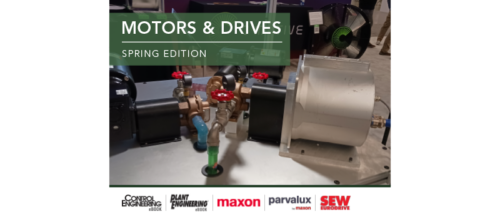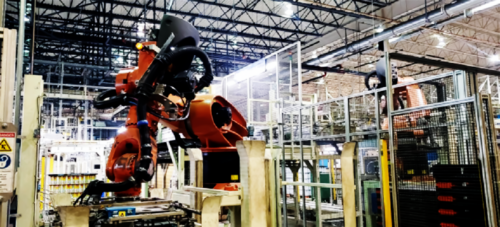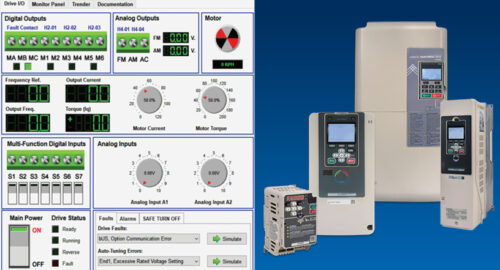Seeing is believing
Control engineers need more than to be told what's going on. They can't take anyone's "word for it." They need to see things for themselves. They need visual reassurance their processes are moving along according to plan, whether that means they're looking at the actual process, or monitoring it with a visual aid.
Control engineers need more than to be told what’s going on. They can’t take anyone’s ‘word for it.’ They need to see things for themselves. They need visual reassurance their processes are moving along according to plan, whether that means they’re looking at the actual process, or monitoring it with a visual aid.
Operator interface (OI) terminals are just such a visual aid control engineers use to monitor their processes and perform control functions. Control Engineering polled 1,500 of its readers to get a grasp of today’s OI terminal market.
The objectives of the study were to qualify respondents who recommend, specify, and/or purchase operator interface terminals; determine features respondents have and features they want; and investigate the changes in operator interface terminal product features over the past five years and perceptions of changes in the next five years.
Four hundred sixteen answered the survey for a 28% response rate.
More than nine out of ten (96%) respondents say they select, specify, or otherwise influence the purchase of operator interface terminals, which qualified them for the study. Sixty-seven percent do it for in-plant requirements, while the rest, 33%, do it for OEM requirements.
How do we define?
The majority of OI terminals are used in process industries, says the survey. Fifty percent of respondents use them for continuous and batch processing, 13% for continuous processing only, and 9% for batch processing only. Discrete parts manufacturing accounted for 24% of the survey’s responses.
But opinions differ as to just what constitutes an OI terminal. To aid engineers with their OI purchases, it might be wise for them to ask manufacturers to define their concept of an OI terminal. To Steve Crass, director of commercial marketing at Xycom Automation (Saline, Mich.), it’s a full-blown computer replete with CPU, motherboard, hard drive, and monitor. To Rockwell Automation’s OI product manager, Mark Hobbs, OI more resembles the Allen-Bradley PanelView, which isn’t a complete PC, but still provides graphics and allows users to affect some aspects of control. Both are right.
Everyone generally agrees that whatever OI’s capabilities, it’s minimum function is some sort of display connected to a programmable controller. The display communicates to the operator, letting that person know what’s going on inside a machine, and may allow some level of control. How the terminal communicates to the operator can differ widely. The terminal can offer a sophisticated graphic display of a process, or it can offer a simple text message.
Up until about four years ago, Rockwell’s PanelView concept of OI would have been more accurate. The relatively high cost of PCs was too prohibitive for most companies to employ the technology widely. Now that PCs are smaller, more powerful, and cost less, they’re becoming a viable option to proprietary, dedicated terminals.
Xycom’s Mr. Crass says there’s no denying the increasing presence of PCs used as OI. He cites PC’s improving graphics, increasing power, and market forces that are continually driving up performance while driving down price as the main forces allowing ‘open technology to deliver more functionality at a similar cost with dedicated, proprietary terminals.’
The results of the survey support his claims. Respondents indicate they’ve sharply increased purchases of computers, color graphic terminals, and touchscreens over the last five years. Monochrome and alphanumeric display purchases have significantly decreased according to the survey.
Over the next five years, respondents say they’ll continue to opt for computers, color graphic terminals, and touchscreens. They say they’ll also look for more network enabled OI terminals.
Haves vs. wants
Of OI terminals in use, it’s a toss up between those rated NEMA12 and NEMA 4/4X as to which is needed most. Fifty-seven percent of respondents say the terminals they use are rated NEMA 12, while 51% of respondents use NEMA 4/4X rated terminals (results exceed 100% due to multiple responses since many operators use terminals in different areas requiring different protection requirements). When respondents purchase their next terminals, preferences for NEMA 4/4X and NEMA 12 are also about equal, 51% to 50%.
Not many respondents require submersion protection. Consequently, only 2% need a NEMA 6 rating on their OI terminals, and only 3% prefer to have a NEMA 6 rating with their next terminals (see March 1999 CE, p. 166 for NEMA rating descriptions).
Flat panels are replacing CRTs, and touchscreens are replacing keypads according to survey results. CRTs still outnumber flat panels 62% to 60% among those in use, but when it comes time to buy new terminals, 68% prefer new purchases to be flat panels; 30% prefer CRTs.
Currently, 73% of respondents use touchscreens compared to 62% that use keypads as input devices. Seventy-two percent prefer to have touchscreens with their next OI purchase while 46% prefer to have their next purchase equipped with a keypad (see graph).
Rockwell’s Mr. Hobbs says much of what determines the choice of touchscreen or keypad is cleanliness of the environment. ‘Touchscreens offer the most intuitive input device, but 40% of our OI terminals come with a keypad because they’re being used in dirty environments. They work better [than touchscreens] with gloved hands,’ he said.
Touchscreens, particularly the capacitive type, aren’t ideal if the operator uses a metal object such as a screwdriver or a key to touch the screen instead of a finger. Abrasions on the screen render the touch input capabilities useless.
What also may determine whether a keypad or touchscreen should be used is how repetitive users will perform functions. Mr. Hobbs says that Allen-Bradley’s OI terminals with keypads are specified to withstand at least two million operations, where their touchscreens are specified to withstand at least one million. ‘Keypads withstand the abuse better,’ he said, ‘but there really are places for both [touchscreens and keypads].’
Readability at a significant distance and in the presence of bright ambient light are important to respondents. Nineteen percent say they can read their terminals from a significant distance, but 36% want that feature with their next terminal. Twenty-one percent of respondents can read their terminals in bright ambient light, but 35% would like this feature in their next terminal.
Proprietary networks are also declining in popularity, according to the survey. Right now, 47% of respondents use proprietary networks to connect OI terminals, but only 25% say they would prefer to have them.
What used to be dominated by proprietary terminals and proprietary software is being invaded by Microsoft Windows CE. Microsoft’s smaller operating system that made a name for itself first with pocket devices is gaining popularity as a control platform. Thirty-one percent of respondents have Windows CE on their OI terminals. Next on the list is Microsoft Windows NT, which is used by 9%. Web browsers garnered 8% of votes, while Java came in with 4%.
If respondents had a say in what their next OI terminal would run on, 43% would install Windows CE, followed by a web browser (17%), Java (10%), and Windows NT (6%).
Future purchasing
The OI market looks to be stable for the next 12 months. Forty-three percent of respondents reported their companies’ purchases of OI terminals will at least remain the same for the coming year. Thirty-one percent said their companies will increase spending for OI terminals, while only 5% said spending will decrease. Seventeen percent said they aren’t certain, and 4% gave no answer.
Operator Interface Products
For more information on operator interface products, circle the following numbers, or go to www.controleng.com/freeinfo .
High-end functionality
Columbus, O.- PanelMate Power Pro 3000 operator interfaces from Cutler-Hammer are able to communicate with multiple PLCs and/or industrial networks simultaneously. These units provide up to 100 pages and 5,000 messages, object-oriented pixel graphics, and 256 color displays. Touchscreen and touchpanel models are available, and the company says it’s the first operator interface to offer an ultra-bright 350 nit TFT 10.4-in. high-resolution display. Tempered glass is offered for high visibility applications. Acrylic screens are offered for applications where glass is not desired. These units are 24 V dc operated have two DB-9 optically isolated serial ports. Cutler-Hammer
Greyline gives control totally
Melrose Park, Ill.- Total Control Products’ 3400 Series operator workstations are multifunction interface devices for information display and data entry. The units are designed to interface directly to a programmable controller using the company’s Quick Connect system, which reportedly eliminates having to use serial ASCII or basic modules or multiple PLC I/O cards. These units use 25-pin, D-type connectors. Stock cables are available to interface with all supported PLCs. Other features include a two- or four-line Vacuum Fluorescent Display with 20 characters per line, 16 tactile dome function keys, 16 independent indicator LEDs, plus a numeric keypad with four additional function keys. Total Control Products
CE adds durability
Saline, Mich.- OpenHMI with Microsoft Windows CE is a new line of factory-floor visualization products for manufacturing and process control systems. OpenHMI products are equipped with flash drives, providing stability and protection against vibration, moisture, and shock hazards. OpenHMI enables operators, engineers, and maintenance personnel to see the process on the factory floor and analyze machine performance. Because OpenHMI used PC-based computing technology, users have the flexibility to determine their own mix of tools for development and runtime. Users can add audio and visual machine set-up, as well as troubleshooting and maintenance diagnostics. Xycom Automation
Family of PCs upgraded
Delta, British Columbia, Canada- Dynapro’s ET 3000 and 4500 computers are available with faster processors, bigger displays, and increased video RAM. The ET 3000 series will carry AMD K6-II 350 MHz processors, which reportedly triple the speed of the series’ previous processors. Display size has been enlarged to 15 in., video RAM has been doubled, and a PCI slot has been added. The ET 4500 and Dynapro 4500 with Microsoft Windows CE series will feature AMD K6-III 400 MHz processors with a bus speed of 100 MHz. Both 4500 series will feature an additional PCI slot, a USB port, and increased video RAM. Dynapro
Allowing configurability
Milford, O.- PowerStation RS (remote station) includes a 12 or 15 in. flat panel monitor coupled with a remote PC box. The high-resolution monitor enhances the overall impact and functionality of the OEM’s machine. The remote PC can be mounted in the machine control enclosure with other control or motion equipment in a controlled environment. The arrangement provides additional reliability and convenience by placing the PC near the PLC or I/O devices, reducing wiring requirements to the operator panel. PowerStation RS is available with a 12 in. SVGA or 15 in. XGA monitor, and 586 or Intel Pentium or equivalent CPU. CTC Parker Automation
Popular OI line enhanced
Milwaukee, Wis.- Rockwell Automation’s popular Allen-Bradley PanelView line of OI terminals now has ControlNet capability, ASCII input, and advanced alarm capabilities. The ASCII input option provides a built-in operator input method for entering alphanumeric character strings. Alarms can be logged historically and also active versus inactive. Pictured is the PanelView 1000e, featuring a 10.4 in. color active matrix TFT display for enhanced color graphics. The 1000e also includes PanelBuilder software, a Microsoft Windows-based graphical interface that helps simplify application design. Rockwell Automation/Allen-Bradley
Displays rated NEMA 4
Fremont, Calif.- Designed for harsh applications, Orca family of panel-mount and rack-mount industrial flat panels is rated NEMA 4. The company says the systems fit well with high-end industrial products. Available in two sizes, 15.1 in. XGA and 18.1 in. SXGA, Orca systems can be specified as simple monitors, or add a Celeron processor and a ruggedized touchscreen, and an Orca system becomes a high-end, net-ready workstation. Dolch Computer Systems
Windows CE, hardware solution
Ann Arbor, Mich.- The ‘paneLink’ is a Microsoft Windows CE 2.12 software/hardware package that features a 200 MHz SH4 processor with 32 MB on-board SDRAM, 32 MB flash ROM, and 128 KB battery backed SRAM. The paneLink also has a built-in Ethernet port, RS-232 port, external alarm, remote reset, and analog touchscreen. The paneLink family of products offers flat-panel display options that include 10.4 in TFT, 12.1 in. TFT, and 6 in. dual scan; paneLink also supports other communication protocols like Profibus, DeviceNet, Modbus, and Data Highway. Ann Arbor Technologies
Digital flat-panel monitor
Ann Arbor, Mich.- Nematron has released what the company says is the first digital flat-panel monitor. Available in 12-, 15-, and 18-in. sizes, the digital technology eliminates display ‘flicker’ commonly found in analog monitors. These monitors are said to provide improved clarity, resolution, and display sharpness. All monitors are anti-glare, which enhances viewing in all lighting conditions. An optional resistive touchscreen is available. Nematron
Backlit LED with touchscreen
Charlottesville, Va.- Datapanel Model 240E is a fully interactive operator interface that has a 240 x 128 pixel backlit LCD with touchscreen. It supports graphic objects such as bar meters, trend graphs, dynamic bit maps, pushbuttons and more. Model 240E also features six programmable function keys and four navigation and editing buttons. A graphic/touch keypad provides numeric data entry. Model 240E also has two com ports for PLC communications and PC/104 support for Genius and Profibus network interfaces. The second com port can also be used for printer output or slave Datapanels. More than 80 serial protocols are available and are included with DataDesigner, GE Fanuc’s software tool designed to configure all Datapanel models. GE Fanuc
ONLINE
OI terminals
Control Engineering Online Extra: Go to
Do you have experience and expertise with the topics mentioned in this content? You should consider contributing to our CFE Media editorial team and getting the recognition you and your company deserve. Click here to start this process.





